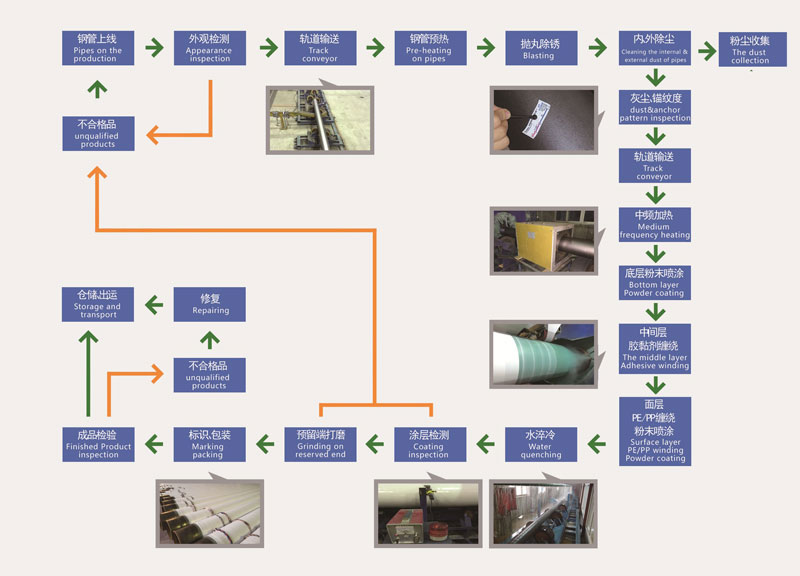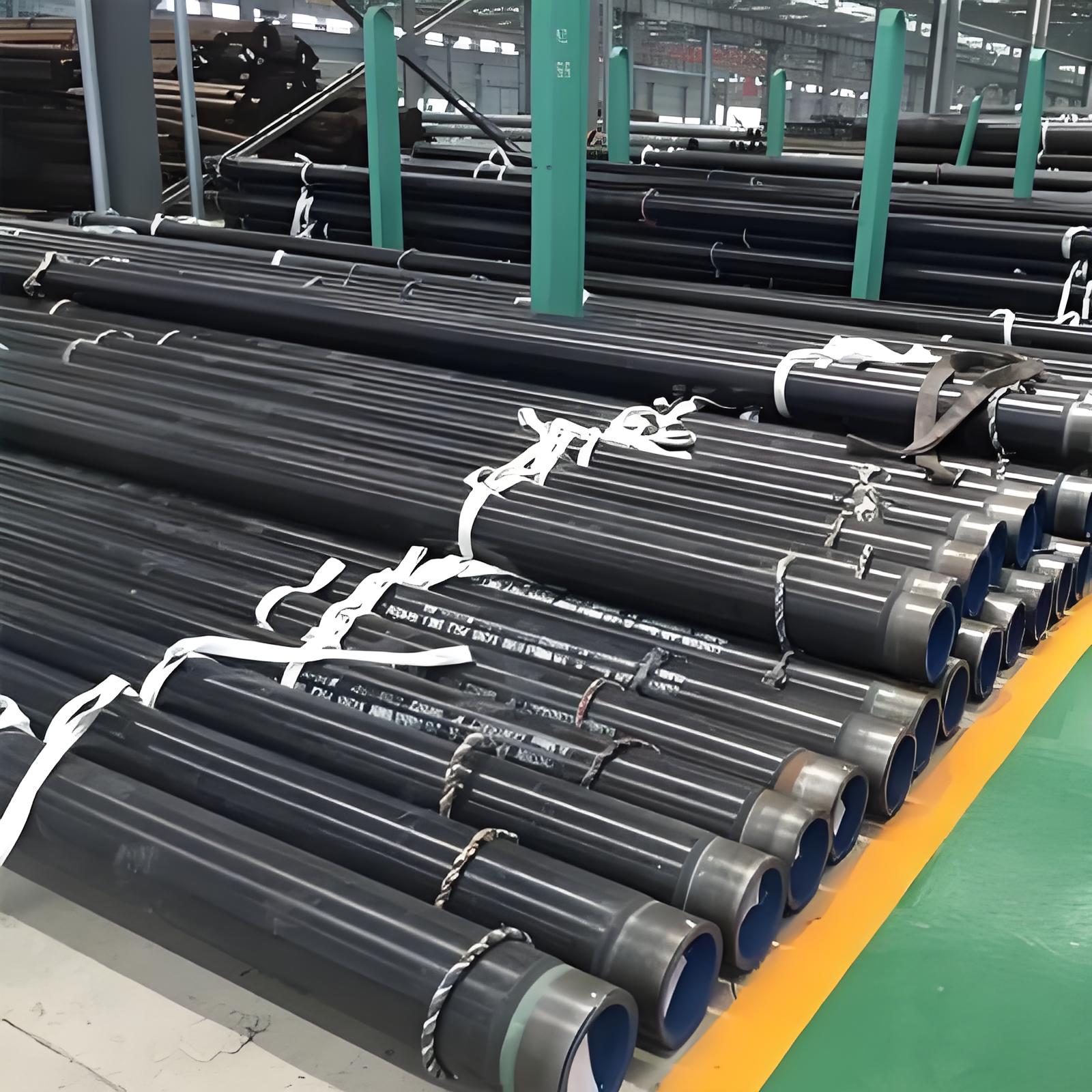DIN 30670 Three-Layer Polyethylene (3LPE) Coated Line Pipe
- Applied Steel Service Pipe: API 5L/ISO 3183 Gr.B-X100, ASTM A53/A106 Gr.B, ASTM A333 Gr.1/3/6, ASTM A671/A672/A691
DIN 30670 Three-Layer Polyethylene (3LPE) Coated Line Pipe
Our DIN 30670 three-layer polyethylene (3LPE) coated line pipe is designed to provide a high-performance, corrosion-resistant solution for pipeline applications. Made from high-quality steel, these pipes are coated with a proprietary three-layer system that consists of an inner layer of polyethylene (PE), a middle layer of adhesive, and an outer layer of polyethylene (PE) that provides a durable, scratch-resistant surface. The 3LPE coating is fully compliant with the DIN 30670 standard, which specifies the requirements for the performance and testing of polyethylene-coated pipes. With their ability to withstand harsh environments and extreme operating conditions, our 3LPE coated line pipes are ideal for use in a wide range of pipeline applications, including onshore and offshore oil and gas transmission, water transmission, and industrial process piping systems. The 3LPE coating provides excellent resistance to corrosion, erosion, and external damage, making it an excellent choice for pipelines that operate in aggressive environments.
Specifications
| Standard | DIN 30670 Three-layer extruded polyethylene coatings on steel pipes and fittings |
| Applied Steel Service Pipe | API 5L/ISO 3183 Gr.B-X100, ASTM A53/A106 Gr.B, ASTM A333 Gr.1/3/6, ASTM A671/A672/A691 |
| Processing ability | OD:38mm-1620mm; WT:2mm-30mm |
| Length | 6-18m |
| Surface Preparation | ISO 8501-1/SIS 055900/DIN 55928 Sa 2.5/NACE No.2/SPCC SP10 (Near White Metal Finish) |
| Coating Structure | First Layer: Epoxy Primer Layer; Second Layer: Adhesive Layer; Third Layer: High-density Polyethylene Layer |
| Packing | 1. Both ends of the pipe are beveled to 30°+5°/-0° according to ASME B16.25. 2. For large-diameter pipes (OD≥NPS 8″), each pipe is equipped with 3 anti-collision ropes (3 locations) and 2 slings, with plastic covers at the ends of the pipes, or reusable metal bevel protectors (with sealing cloth), loosely packed. 3. For small-diameter pipes (OD≤NPS 6″), each pipe is equipped with 3 anti-collision ropes (3 locations), plastic covers at the ends of the pipes, and 2 slings per bundle (the whole bundle can be wrapped in a woven bag according to the coating type or customer requirements) and tied with plastic strips (woven bags are placed underneath to protect the coating from scratches) |
| Technique | Coated on Seamless/ERW/HFW/LSAW/SSAW/JCOE/UOE/RBE Line Pipes |
| Service condition | Design working temperature ranges: -40℃ to +80℃; alkaline or sour service |
| Place of Origin | Made in China |
| MOQ | Depends on order quantity |
| Transportation | Railway, By Sea |
| Type of DIN30670 3LPE/3PE coating | ||
| Type | N | S |
| Design temperatures for sintered polyethylene coatings | from −20 °C up to +50 °C | from −40 °C up to +70 °C |
| Design temperatures for extruded polyethylene coatings | from −20 °C up to +60 °C | from −40 °C up to +80 °C |
| 3LPE Coating thickness | ||
| Nominal size DN | normal (n) | increased (v) |
| DN≤ 100 | 1,8 | 2,5 |
| 100< DN≤ 250 | 2,0 | 2,7 |
| 250 < DN< 500 | 2,2 | 2,9 |
| 500 ≤ DN <800 | 2,5 | 3,2 |
| DN ≥800 | 3,0 | 3,7 |
| DIN30670 3LPE/3PE Coating Performance | |||
| Property | Requirement | Testing as in | Notes |
| Degree of cure of epoxy resin | ΔTg according to the manufacturer’s specification | Annex B | |
| Cathodic disbondment (CD test) | 23 °C/28 d or 60 °C/2 d max. 7 mm | Annex C | Applies only to three-layer coatings |
| Peel strength | Type N: 100 N/cm (23 °C) 20 N/cm (50 °C) Type S: 150 N/cm (23 °C) 30 N/cm (70 °C) |
Annex D | For system testing single values shall be no more than 25 % lower than the required average value. |
| Continuity (holiday detection) | No discharges | Annex E | 25 kV test |
| Elongation at break (23 °C ± 2 °C) | min. 400 % | Annex F | |
| Impact resistance (23 °C ± 2 °C) | Type N: ≥ 5 J/mm Type S: ≥ 7 J/mm |
Annex H | 25 kV test No discharges |
| Low-temperature impact resistance | Type N: ≥ 5 J/mm (−20 °C ± 2 °C) Type S: ≥ 7 J/mm (−40 °C ± 2 °C) |
Annex H | 25 kV test No discharges |
| Indentation resistance | Type N: max. 0,2 mm (23 °C) max. 0,3 mm (50 °C) Type S: max. 0,2 mm (23 °C) max. 0,4 mm (70 °C) |
Annex I | |
| Specific electrical coating resistance (23 °C ± 2 °C) | ≥ 108Ωm² | Annex J | |
| UV resistance | ΔMFR ± 35 % | Annex K | |
| Thermal aging resistance | ΔMFR ± 35 % | Annex L | |
3LPE Coating Production Process

Applications of 3LPE Coated Line Pipe
3LPE coated line pipes are used in a variety of applications, similar to 3LPP coated pipes, with some specific advantages in certain conditions:
Oil and Gas Pipelines
Onshore and Offshore Pipelines: Used extensively for transporting oil and gas due to its excellent resistance to corrosive environments and mechanical damage.
Subsea Pipelines: Ideal for subsea applications where the pipes face harsh marine conditions and mechanical stresses.
Water Pipelines
Potable Water Pipelines: Suitable for carrying potable water due to its non-toxic nature and excellent corrosion protection.
Sewage and Wastewater Pipelines: Used in sewage and wastewater systems to protect against corrosion and mechanical wear.
Chemical and Petrochemical Pipelines
Transport of Chemicals: The chemical resistance of polyethylene makes these pipes suitable for transporting various chemicals.
Petrochemical Plants: Used in environments where pipes are exposed to aggressive chemicals and require reliable protection.
Industrial Applications
Cooling Water Systems: Employed in cooling water systems in industrial facilities for their durability and corrosion resistance.
Slurry and Mining Pipelines: Used in mining for transporting abrasive slurries due to their mechanical strength.
District Heating and Cooling Systems
District Heating Pipelines: Suitable for district heating systems to transport hot water or steam, providing thermal insulation and corrosion protection.
District Cooling Pipelines: Used in district cooling systems to transport chilled water, protecting against external moisture and corrosion.
Renewable Energy Projects
Geothermal Pipelines: Ideal for geothermal energy projects where the pipes transport corrosive geothermal fluids.
Hydropower Plants: Used in hydropower plants for their resistance to continuous water flow and mechanical stresses.




